
 In Airport ’77, the third in the Airport series, a private Boeing 747 is transporting the art collection and friend of multimillionaire Philip Stevens (James Stewart, Vertigo) to the opening of his new museum. Says Stevens to a throng of reporters, “It’s going to be a real wingding.”
In Airport ’77, the third in the Airport series, a private Boeing 747 is transporting the art collection and friend of multimillionaire Philip Stevens (James Stewart, Vertigo) to the opening of his new museum. Says Stevens to a throng of reporters, “It’s going to be a real wingding.”
Based on that jet alone, the old man ain’t joking! Under the control of Capt. Gallagher (Jack Lemmon, Glengarry Glen Ross), the aircraft boasts three luxurious levels that include bedrooms, office space, tabletop Pong, copies of Ebony magazine and even a blind lounge singer/pianist (motivational speaker Tom Sullivan) whose dark glasses look specially designed for Elton John to wear for an hour after getting his eyes dilated. Unbeknownst to Stevens, Gallagher or Gallagher’s mustache, the night flight also hosts a cadre of art thieves who gas the crew and passengers asleep so they can take over and make off with the priceless paintings. But art thieves do not double as ace pilots; a clipped wing sends the Boeing to the bottom of the ocean, square in the Bermuda Triangle — for no reason other than Trianglesploitation was a trend at the time.
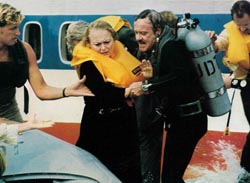 With the submerged plane taking in water, Airport ’77 appears to be cribbing from The Poseidon Adventure of five years earlier. No stranger to the disaster genre, director Jerry Jameson (Raise the Titanic!) spends ’77’s second hour detailing and depicting the rescue efforts of Gallagher on the inside and the combined might of the U.S. Navy and Coast Guard on the outside. However, this removes focus from the most fun part of these exercises in cinematic calamity: the all-star cast. This TV-looking sequel is as overstuffed as the rest, with faded idols (Olivia de Havilland, Joseph Cotten), up-and-comers (Kathleen Quinlan, M. Emmet Walsh) and then-current leading ladies (Brenda Vaccaro, Lee Grant — the latter cutting the largest slice of the overacting pie). Returning as Joe Patroni, George Kennedy shows up just long enough to allow ’77 a direct connection to the previous two pictures.
With the submerged plane taking in water, Airport ’77 appears to be cribbing from The Poseidon Adventure of five years earlier. No stranger to the disaster genre, director Jerry Jameson (Raise the Titanic!) spends ’77’s second hour detailing and depicting the rescue efforts of Gallagher on the inside and the combined might of the U.S. Navy and Coast Guard on the outside. However, this removes focus from the most fun part of these exercises in cinematic calamity: the all-star cast. This TV-looking sequel is as overstuffed as the rest, with faded idols (Olivia de Havilland, Joseph Cotten), up-and-comers (Kathleen Quinlan, M. Emmet Walsh) and then-current leading ladies (Brenda Vaccaro, Lee Grant — the latter cutting the largest slice of the overacting pie). Returning as Joe Patroni, George Kennedy shows up just long enough to allow ’77 a direct connection to the previous two pictures.
Many of the actors’ clothes sport gaudy, checkered prints that create moiré patterns on your TV screen. Those have more life than poor Stewart, so folksy and noncommittal that one half-expects him to recite that poem about his dead dog. Haven’t heard it? Oh, it’s a real wingding. —Rod Lott


 True or false: The movie
True or false: The movie 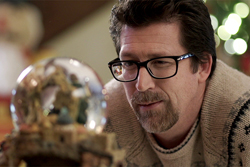
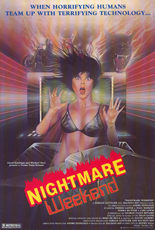


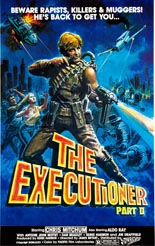
 First things first regarding The Executioner Part II: There is no part 1. Well, there is — it’s just that as a
First things first regarding The Executioner Part II: There is no part 1. Well, there is — it’s just that as a 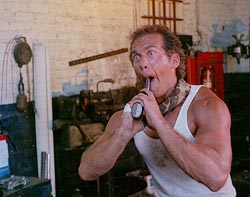 That said, I feel like none of these leads did much; O’Malley mostly sits in chairs. Not enough forward motion exists in this supposed main plot to justify referring to the rest as “subplots.” But what else to call them? The most prominent has O’Malley’s gap-toothed, cash-strapped high school daughter (Bianca Phillipi) jonesin’ so hard for “dope” that she follows her ever-giggling BFF (Marisi Courtwright) into part-time hustling. There’s also a street gang that seems straight out of Sharks and Jets territory, talk of a dreaded “Tattoo Man,” and a sex fiend with a bowl haircut and a habit of ripping open the blouse (sometimes the same one) of his lucky partner. Talk of The Executioner Part II isn’t complete without mentioning “Big Dan” (Dan Bradley, director of 2012’s
That said, I feel like none of these leads did much; O’Malley mostly sits in chairs. Not enough forward motion exists in this supposed main plot to justify referring to the rest as “subplots.” But what else to call them? The most prominent has O’Malley’s gap-toothed, cash-strapped high school daughter (Bianca Phillipi) jonesin’ so hard for “dope” that she follows her ever-giggling BFF (Marisi Courtwright) into part-time hustling. There’s also a street gang that seems straight out of Sharks and Jets territory, talk of a dreaded “Tattoo Man,” and a sex fiend with a bowl haircut and a habit of ripping open the blouse (sometimes the same one) of his lucky partner. Talk of The Executioner Part II isn’t complete without mentioning “Big Dan” (Dan Bradley, director of 2012’s 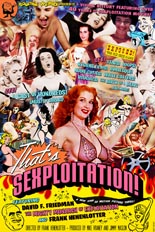
 In conjunction with the mighty
In conjunction with the mighty  But wasn’t it fun while it lasted? Henenlotter is out to prove that with an emphatic “hell, yes!” With a cup-runneth-over wealth of clips, the doc beckons you through the entire tits-a-twirlin’ timeline of subgenres: morality scares (
But wasn’t it fun while it lasted? Henenlotter is out to prove that with an emphatic “hell, yes!” With a cup-runneth-over wealth of clips, the doc beckons you through the entire tits-a-twirlin’ timeline of subgenres: morality scares (